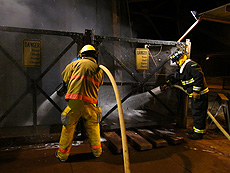Soudan mine shaft fire 99 percent out

Firefighters send foam and water down the Soudan mine access shaft on Friday night. Photo: Minnesota Incident Command Center.
Over the weekend, the Minnesota Interagency Fire Center provided updates on the situation at the Soudan Underground Mine, which houses two Fermilab experiments. Responders to the mine shaft fire reported Sunday that a fire which began the evening of Thursday, March 17, appears to be out, but they were not able to determine its exact location. The Soudan mine is owned and managed by the Minnesota Department of Natural Resources. The Soudan Underground Laboratory, which is managed by the University of Minnesota, is located on level 27 of the mine, about a half-mile underground. The laboratory houses the far detector for the MINOS neutrino experiment and the detector for the Cryogenic Dark Matter Search experiment.
A three-man team, using the mine's operational elevator, descended slowly into the shaft on Sunday, dropping to level 27 in the mine. It was their first descent into the shaft after thousands of gallons of foam and water had been sprayed into the mine. The team was only able to descend after determining that carbon monoxide levels were safe and underground communications were established with the surface.
The crew did not find any active fire. They started critical sump pumps on levels 12 and 22, and water is flowing from the sump pumps to the surface. On level 27, the mine's lowest level and where a third pump is located, they encountered large amounts of foam. The crew tested communications from that level, but did not enter the laboratory chamber.
Fire officials will not declare that the fire is officially out until its source has been located and any smoldering ashes or embers have been extinguished. Sunday's inspection did not indicate the location of the fire. The cause has not been determined.
The fire was detected at around 9 p.m. on Thursday evening. No personnel were in the mine at the time. Smoke continued to come out of the access shaft Friday. Minnesota DNR officials said in a press release on Friday that they believe the fire was burning inside the shaft between levels 23 and 25 in the mine. The Soudan Underground Laboratory is located further down the shaft.
The fire detection system cut off the power to the underground laboratory on Thursday evening, as it is designed to do in the event of a fire alarm. Battery-powered backup systems continued for some time to power equipment in the underground laboratory, including infrared-sensitive video cameras. Dan Bauer, Fermilab Operations Manager for experiments at Soudan, said that laboratory staff did not detect any smoke or fire in the underground laboratory while the cameras were working. By Saturday morning the backup batteries for the cameras were exhausted and scientists lost contact with all equipment in the underground laboratory.
"We are blind to the actual status of the laboratory and its equipment until we can go inside the underground laboratory again," Bauer said.
Fire doors separate the MINOS cavern and the CDMS cavern from the area next to the Soudan mine access shaft. Because there is a strong upward draft in the access shaft and the video images showed no evidence of smoke in the underground laboratory on Friday, scientists are optimistic about the state of the experiments. Responders found no water on the floor when they arrived at the 27th level on Sunday.
On Saturday, responders discovered that the cages had not been damaged by the fire (see Saturday evening's press release). The ability to raise and lower the cages allowed the staff to send monitoring equipment down the shaft, including a carbon monoxide monitor, temperature gauges and a camera that provided critical information about the condition of the shaft.
The response to the incident involved many different agencies. They included the Breitung Township and Tower Volunteer Fire Departments, Inver Grove Heights Fire Department, staff from the Minnesota Department of Natural Resources, the University of Minnesota and the U.S. Department of Energy.
The U.S. Department of Energy, the U.S. National Science Foundation, and several international funding agencies support the MINOS and CDMS experiments.
More information is available on the Minnesota Incident Command System website.
|